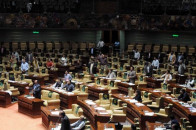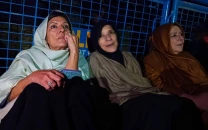The soul of the city has lost its charm
Karachi Conference session dissects Saddar and its inhabitants
The event featured three presentations by an architect, teacher and student. PHOTO: ATHAR KHAN/EXPRESS
Habibi, a partner at M/s Consultants Group, is part of the World Bank-sponsored rehabilitation of Saddar. The revitalization of the area was started three years ago, he told the participants in a long-winded but interesting speech. He explained how the project aims to make a huge section of the neighbourhood – from Empress Market to Pakistan Chowk and MA Jinnah Road to MR Kiyani Road – a ‘human friendly’ pedestrian zone.
“[Saddar comprises] diverse land use with deteriorating infrastructure, decaying built environment and neglected heritage buildings,” said Habibi, adding that Saddar is the epitome of the city’s former glory.
He lamented that the human aspects of the design had been lost, as the area had fallen victim to the increased use of motor vehicles which claimed footpaths and road space.
Karachi Conference to kick off on Friday
The architect said the intelligentsia was partly to blame for the shoddy state of the area, as they engaged in useless discussions but did nothing for the city’s development. “We want our lost memory back,” he said, explaining that his firm had prepared recommendations for planning considerations and measures.
Part of those measures included focusing more on the aesthetic value of the buildings and liberating design from ‘technocratic practices’. His plan included the creation of nine zones in Saddar and the rerouting of traffic, thereby transforming the area “from a thoroughfare to a destination”. The zones were divided into food and recreation, two for administration, culture, education, neighbourhood, recreation, commercial cum residential and one for open forum discussions. For example, Arts Council and NAPA fall in the cultural zone.
Many of these areas, such as Jahangir Park, Bohri Bazaar, Talpur Road and Empress Market, would be pedestrianised, thereby catering to people’s needs, according to him. The area would have bus stops but not transit yards, he explained, thereby reducing traffic considerably. He also suggested that by moving transit yards, street hawkers would also eventually shift in order to target their customers. His recommendation to reroute traffic entirely was met with skepticism, as people questioned whether he had taken the Green Line Bus Rapid Transit project into account.
To resolve the parking issues Saddar is famous for, he suggested parking sites be established after every 500 metres, adding that 18 sites have been selected for this purpose. One of his suggestions also included opening Burnes Garden for the public and breaking down its boundary walls.
Jahangir Park restored to its former glory
However, Habibi’s claims of having consulted with all stakeholders were proven wrong, drawing criticism from many audience members, including architect Marvi Mazhar, who questioned why an urban narrative was not included in the presentation. Other audience members came to Habibi’s defence, suggesting that while the project’s aim was noteworthy its implementation should not create additional difficulties for residents.
The next presentation was by Rudaina Siddiqi, a teacher at The Lyceum. She discussed the aspect missing from Habibi’s presentation – the people. She spoke about shopkeepers and hawkers at Empress Market with a focus on the cultural and historic significance of the area and the people.
Historically, the area was a punishment ground for freedom fighters in 1857 and was named ‘Toap Dam’. In order to wash away the area’s bloody history, the British set up a market, which was initially used exclusively by the British elite. It was later opened to the public.
The market comprises 250 shops of varying sizes with 120 on the periphery. It is populated by a number of second or third generation shopkeepers, including some Zoroastrian ones, many of whose families have been working there for up to 70 years. There are six Hindu women selling dry fruit at the market, Siddiqi said, adding that when asked whether they have ever been harassed in any way at work, the women said no one would dare because they had been staples of the market for years.
Shopkeepers, traders urged to keep their areas clean
Twenty thousand customers visit Empress Market every day, she said, explaining that the market was embedded in the shopkeepers’ lives.
She went on to discuss the extortion demanded of the shopkeepers, putting the daily collection in Saddar at Rs12.5 million.
The teacher said only 55% of the shopkeepers knew that a plan to rehabilitate Saddar was afoot, but they were convinced that the plan included their eviction. There is a lot of mistrust in the area after the Shahabuddin Market incident, she told the audience.
“Rehabilitation plans should include shopkeepers,” she urged, adding that the gentrification of the area has many shopkeepers worried if there is a place for them in the new and improved Saddar.
The last presentation was by Bushra Sarwar, a final-year student at Dawood University of Engineering Technology, who was the only student to be part of a panel. She discussed the rehabilitation of Jahangir Park.
'No parking will be allowed on main roads in Karachi'
Gifted to the people of Saddar in 1883 by a Zoroastrian philanthropist, Behramji Jehangirji Raj Kotwala, the park served as a recreational and political space. Sarwar spoke from a conservationist’s point of view and heatedly argued in favour of keeping the old rather than creating new.
While appreciative of Chief Minister Murad Ali Shah’s recent rehabilitation of the park, she expressed dismay that the park’s historical value had diminished by not staying in true with the original plan.
“The park was based on a French gravel garden,” she explained, adding that it was once famous for political meetings, hosting religious events, cricket matches and public forums.
“It was once used by muhallay walas [local residents] but today there are no muhallay walay,” she lamented. Sarwar said the park “doesn’t align with the context of Saddar” with its aviary and dinosaur park.
“It was not just a park but an enduring site of historic significance,” she said, adding that preservation is the ultimate form of recycling.


















COMMENTS
Comments are moderated and generally will be posted if they are on-topic and not abusive.
For more information, please see our Comments FAQ